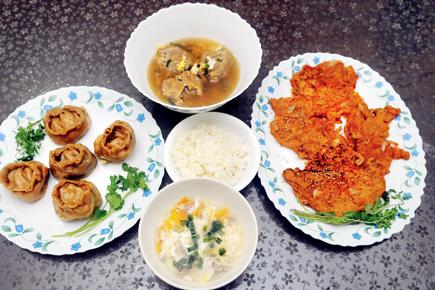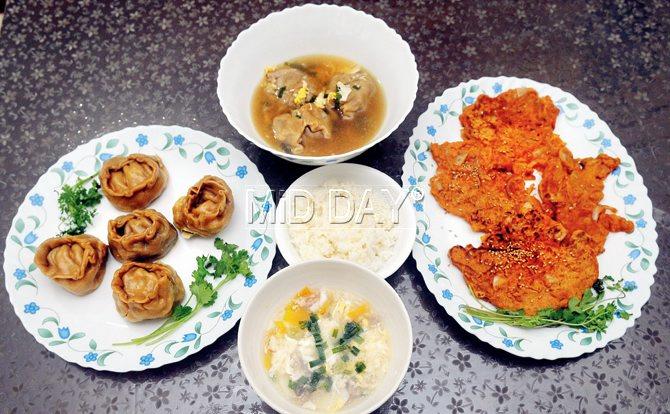As Mumbai-based Korean Hemi Baik hosts a dumpling making class and a Korean language session, here's a lowdown on her native cuisine

Hemi Baik
When Seoul-born Hemi Baik stepped into Mumbai this February, the first place she visited was Mannat in Bandra. "I would watch Bollywood movies, so seeing Shah Rukh Khan's house was exciting. I love that Mumbai is the city of Bollywood," says the excited 32-year-old Korean, who is among 300-odd Koreans living in the city.
ADVERTISEMENT

A Korean fare by Hemi Baik: (clockwise from left) mandu or Korean dumplings; Manduguk, the dumpling soup; Kimchijeon, pan-fried pancakes; and the traditional Tteokguk, a broth cooked with rice cakes (in the centre)
Baik has been staying in Andheri for six months now, and is a professional meditation guide. She is also part of the Mumbai Korean Culture Club and conducts many activities to introduce Mumbaikars to Korean culture. This weekend, Baik will host a Korean cooking class where patrons can learn how to cook mandu a.k.a Korean dumplings as well as take lessons on Korean language. Here is Baik's guide to Korean food:

Korean national, Hemi Baik prepares Kimchijeon in the kitchen of her Andheri apartment. Pics/Nimesh Dave
Korean staples
>> Rice, vegetables and meats form the core of the Korean cuisine. Side dishes (banchan) often accompany traditional Korean meals while kimchi is part of every meal.
>> Koreans love their soups (guk) as part of their mains. Their soups are often made with meats, shellfish and veggies. Other staples include guksu (noodle dishes), jeon (savoury pan-fried pancakes made with kimchi or seafood and wheat flour batter) as well as bibimbap (warm rice served with sautéed vegetables and different sauces) that is popular in their vegetarian fare.
Ingredients
>> The most common ingredients used in Korean cuisine include onion, minced garlic, ginger, anchovy, chilli pepper powder, sesame oil, soy sauce, doenjang (fermented bean paste) and gochujang (fermented red chilli paste). "While I get the vegetables from a local market near my house, I order other ingredients like dried seaweed and seafood, doenjang and gochujang online or get them from my friends visiting from Korea," says Baik.
Main techniques
>> To make good Korean food, balance the taste of the ingredients and the sauce. "In Korea, we call it son mat (hand-taste) which means using your hand to mix the different ingredients and blend them well together. Traditionally, mothers would mix ingredients using their hands because the temperature of the hand helps the ingredients to blend well," informs Baik. This technique is mainly used in preparing the filling for the Korean dumplings.
>> Korean food is touted as healthy as most of it boiled or blanched. "To blanch it well, avoid boiling the food for a long time. When you are cooking noodles in a soup, keep a check on the time to get the right chewy texture of the food," she adds.
On: August 15 (6.30 pm) and 16 (5 pm)
At: B 808, Adityavardhan Apartment, Saki Vihar Road, Andheri (E);
Cost: Rs 300
RSVP: 7715914705
Note: Carry rolling pin and board
Mumbai on my mind
First local train ride: To Mumbai Central to visit the Korean Consulate. It was exciting to see people hanging on the door and feeling the wind. I felt I could travel anywhere by train.
Favourite landmark: Hanging Gardens at Malabar Hill. The old British-style buildings and the view from the hill was so amazing, it felt as if I was in a movie.
Favourite eatery: It's Global Fusion. I enjoy the oriental cuisine from Japan and China as I miss the taste of
soy sauce.
Favourite Mumbai street fare: Pani Puri. The round shape and soup inside was new. I was very happy about the fact that it was reasonably priced.
K for Korean
Along with the cooking class, Baik will also be conducting a talk on Korean language. "Surprisingly, Korean language is similar to Indian languages. For instance, 'abba' means dad is Korean too. The grammar order is same as Hindi and there are almost same or in fact, less consonants as in Hindi, so pronouncing and reading is not difficult. Japanese is most similar to Korean and much of our vocabulary has been derived from the Chinese language," informs Baik.
 Subscribe today by clicking the link and stay updated with the latest news!" Click here!
Subscribe today by clicking the link and stay updated with the latest news!" Click here!






